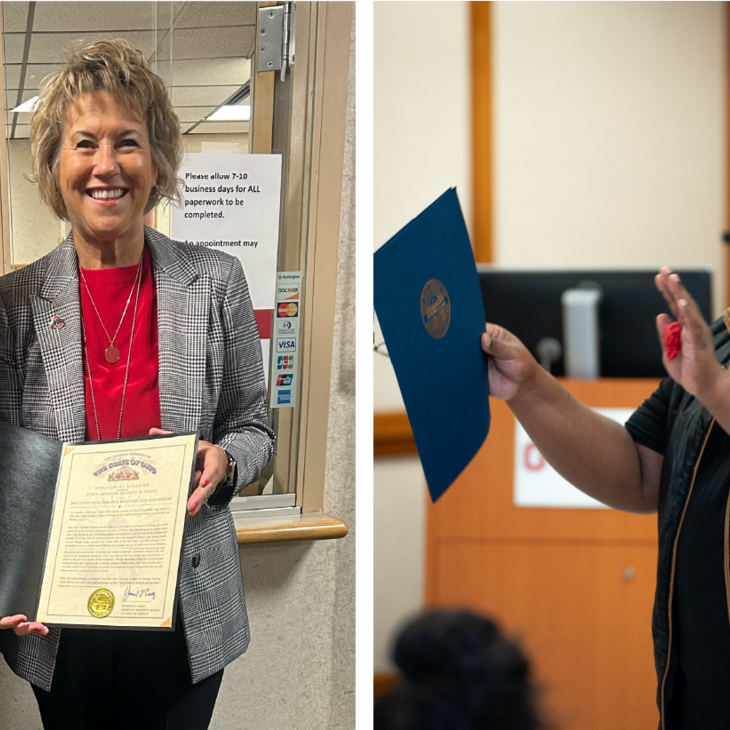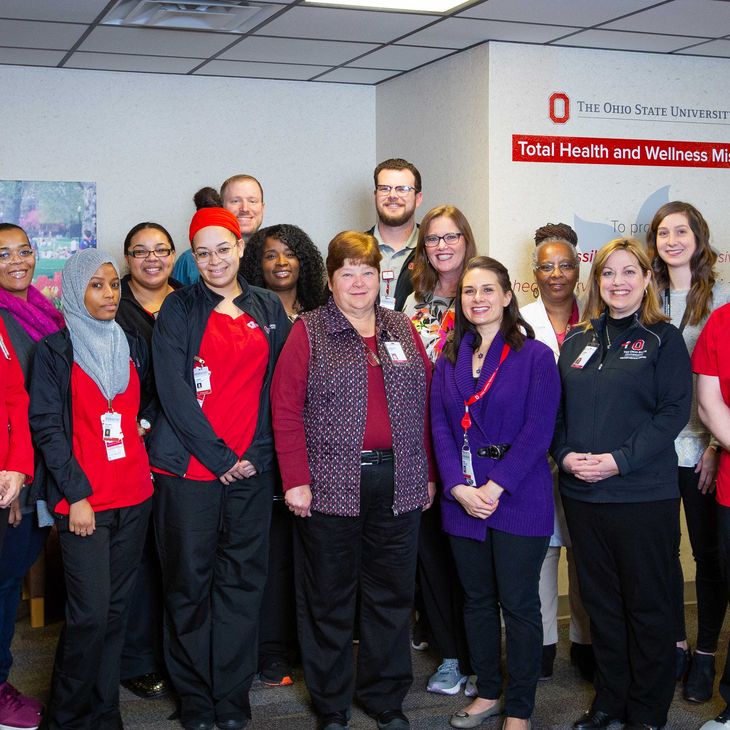The Ohio State University College of Nursing incorporates telehealth across nursing curricula with innovative techniques, tools, pedagogy and learning environments to prepare students for the healthcare of today and tomorrow.
Access to healthcare services is limited for 84 million people who live in the 7,176 Health Professional Shortage Areas (HPSAs) in the United States. Telehealth – the use of digital information and communication technologies to provide healthcare services remotely – offers a promising solution to address this crisis. While some institutions of higher education teach telehealth content, few are actively engaged in teaching their health sciences students through clinical opportunities, and fewer still are evaluating how students use telehealth to provide patient care. Meanwhile, Ohio State is preparing undergraduate, graduate and doctoral nursing students to deliver telehealth care using immersive, experiential learning strategies.
The use of telehealth in clinical nursing practice is spreading widely. For Alice Teall, DNP, APRN-CNP, FAANP, assistant professor in the College of Nursing, merely familiarizing her online students with the concept of telehealth was not enough. “The biggest push for me was not about introducing students to the concept, but ‘How are we going to know our online nurse practitioner students are prepared for practice?’” That question brought its own challenges: creating online learning environments for simulating care by telehealth, reimagining methods and tools to measure and assess student learning and performance with telehealth, and partnering with a team of faculty, clinicians, and instructional designers to expand nursing student opportunities to learn telehealth across on-campus programs.
Innovative pedagogy meets technology
Teall and faculty at the College of Nursing created, and continue to create, new educational materials to address these needs. Perhaps the most innovative has been their work with “standardized patients” – actors hired to role-play as patients – to create videos and livecasts of patient case study situations. Using web conferencing, a standardized patient can appear onscreen in classrooms online or on campus, and can speak to each student individually or to groups of students. Standardized patients are trained to act like real patients, and may forget things, answer the wrong questions, or act surly when in pain, so that students get to experience what it’s like to triage difficult situations.
The faculty have also created “store and forward” recordings of standardized patients that can be used to simulate real patient phone calls, questions, and concerns. Cases include behavioral health issues and pediatric exams, in which the student might need to engage with a concerned standardized patient parent to obtain information. Case recordings and the standardized patient scenarios are re-useable assets that instructors share to include telehealth opportunities across specialties and programs.
Instructors new to telehealth benefit from a “telehealth toolkit” Teall and others devised. It includes checklists, timelines and practical information, such as how to use telehealth equipment. “We started writing out everything we do in a checklist format so that faculty can replicate telehealth simulations and exams easily,” Teall related. This collection of pedagogy, case studies, and tools continues to grow and could be exported to other institutions to increase telehealth education nationally.
Ohio State’s innovative online programs immerse students from across the country in learning telehealth technology. Online nursing graduate students attend lectures about telehealth technologies. They practice e-visit videoconferencing and simulate providing care using telehealth exam stations. Later, they are precepted in clinical experiences using telehealth. During the final two semesters of the program they complete objective, structured clinical exams on their use of telehealth technologies and their etiquette as telehealth providers.
Ohio State’s Lima campus telehealth clinic
Ohio State’s commitment to telehealth goes beyond teaching: they have their own telehealth clinic. In early 2018, the College of Nursing opened a telehealth clinic on their Lima campus (a rural extension campus in an HPSA) to provide care to their students, faculty and staff. The clinic is staffed by a nurse and linked via state-of-the-art telehealth equipment to Total Health and Wellness (THW), a nurse practitioner-led, interprofessional clinic operated by the college that is designated as a Federally Qualified Health Center Look Alike. Using Bluetooth technology, a nurse practitioner at THW can assess the heart sounds of a patient being examined by a nurse from 100 miles away as clearly as if she were in the room. The nurse at the clinic acts as the nurse practitioner’s hands, performing the exam using Bluetooth-enabled devices such as an otoscope, blood pressure cuff and stethoscope. Meanwhile, both nurse and patient can see and talk to the nurse practitioner from the clinic, who appears on a two-way video conferencing screen. Interdisciplinary health sciences students are precepted as healthcare providers at the clinic.
What’s it like to use the telehealth clinic? “The patients love it,” Teall said. And as the on-screen nurse practitioner, she has enjoyed using the state-of-the-art equipment. This video equipment has no lag time, echo or scratchy sound to distract the patient—“That would never work,” Teall asserted—“You (the patient) don’t want to share personal information with someone who sounds like the Wizard of Oz.” Instead, “I’ve had people who have said, ‘Oh my gosh, this really is like you are sitting right here.” And there are advantages, such as the Bluetooth otoscope which magnifies the image of the eardrum and shows it in high definition, “so that the patient and I can really see it,” Teall says. Nursing students learn the special techniques of using this equipment, both in the nurse and nurse practitioner roles. For instance, Teall says, it’s important for nurses to learn not to step between the stethoscope and the broadcasting equipment, or to look at the video screen when they should be looking in the patient’s ear. Equally important, nursing students learn new ways of using telecommunications to talk to their patients and put them at ease.
Telehealth etiquette
Students learn and practice telehealth techniques so that they will be knowledgeable and comfortable when the time comes, and so that they can help patients feel comfortable, too. For instance, Teall explained, “If you are sitting in front of a camera as the provider and the patient is on the other side of the screen, you have to remember that all they can see is your head. So, when you start charting or documenting their visit using your computer, it’s important to say, ‘I’m going to turn my head. I’m going to put this into the computer now.’ Otherwise, all the patient sees is their provider not looking at them anymore.” Explaining the moves you’re making with equipment off-camera helps build patient trust, as does explaining off-camera sounds. If someone enters the room, Teall advises students to introduce any new people who enter the room before they are in sight, and explain why they’re there.
Students practice presenting as an onscreen healthcare provider. “The telehealth exam station transmits high-def sound and picture,” Teall explained, and it takes a bit of getting used to. “You have to not wear jewelry,” because clinking sounds can amplify greatly, and “sometimes you think you’re looking at the person, but you might not be if you are not looking at the webcam. So, we have to teach students to look directly at the camera and not necessarily at the picture on the screen; otherwise the person thinks you’re always looking at their shirt.” During online exams, students are graded in part on their etiquette, which includes how they communicate with patients and the attending nurse at the clinic.
When learning to care for patients calling in from remote locations, students are taught to ask, “Are you in a secure place? Are you in a place where we can talk confidentially?” Even if the patient can’t talk out loud, a secure conversation may be possible via texting. Practicing scenarios like these can help future healthcare providers keep a level head when treating telehealth patients in emergency situations.
Ohio State’s innovative online pedagogy includes simulated patient exams using telehealth stations on campus that are like those used at the Lima telehealth clinic. “Patients” range from patient actors to real people with medical conditions who have volunteered to help educate student nurses. “Pregnancy is one of the cases that we do,” Teall related. “Every 15 to 20 minutes, one of our students calls in, and the student has to orchestrate a prenatal visit. That’s how we know they can do it.” The student might listen to the baby’s heartbeat remotely and ask the mother questions about her health. Care is taken to educate students on implicit bias and cultural sensitivity as well.
Telehealth in your pocket
Ohio State is preparing students to attend to patients at a distance using technologies available almost everywhere: internet and cellphones. “This is about how to increase access to care. People who have low access to care, whether the reasons are geographic or financial, usually have a smartphone. And when a parent can access a provider by calling on their phone, there’s research that says if they share a picture or video of their child, this gives them more confidence that the provider knows what’s going on and it gives the provider more confidence that they were able to assess their child better,” Teall said. Parents using smartphone apps may be less likely to unnecessarily take a child to the ER or repeat a hospital visit.
The future
The College of Nursing seeks to further its mission of transforming health and transforming lives by educating the nursing workforce of the future in telehealth so that they may provide care at a distance and address the health professional shortage crisis. Faculty continue to expand the library of telehealth exam simulation cases, and to reimagine telehealth pedagogy. Future goals include expanding, refining and publishing their telehealth toolkit of educational methods, clinical practice tools and techniques. The college’s approach to telehealth education is scalable, cost-effective and is producing great results and marketability for its graduates, who have practical experience in telehealth and are ready to work as providers of telehealth care to those in need.


